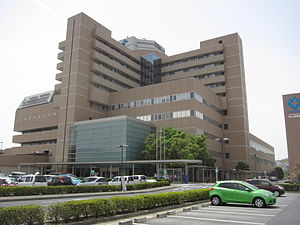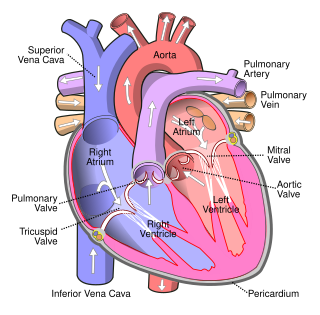The National Hospital Organization Okayama Medical Center is a medical centre in Okayama, Japan. It is where innovations have taken place in pulmonary hypertension. [1] [2]

The National Hospital Organization Okayama Medical Center is a medical centre in Okayama, Japan. It is where innovations have taken place in pulmonary hypertension. [1] [2]


Tadalafil, sold under the brand name Cialis among others, is a medication used to treat erectile dysfunction, benign prostatic hyperplasia, and pulmonary arterial hypertension. It is taken by mouth. Onset is typically within half an hour and the duration is up to 36 hours.

A pulmonary artery is an artery in the pulmonary circulation that carries deoxygenated blood from the right side of the heart to the lungs. The largest pulmonary artery is the main pulmonary artery or pulmonary trunk from the heart, and the smallest ones are the arterioles, which lead to the capillaries that surround the pulmonary alveoli.

Pulmonology, pneumology or pneumonology is a medical specialty that deals with diseases involving the respiratory tract. It is also known as respirology, respiratory medicine, or chest medicine in some countries and areas.

Atrial septal defect (ASD) is a congenital heart defect in which blood flows between the atria of the heart. Some flow is a normal condition both pre-birth and immediately post-birth via the foramen ovale; however, when this does not naturally close after birth it is referred to as a patent (open) foramen ovale (PFO). It is common in patients with a congenital atrial septal aneurysm (ASA).

Pulmonary hypertension is a condition of increased blood pressure in the arteries of the lungs. Symptoms include shortness of breath, fainting, tiredness, chest pain, swelling of the legs, and a fast heartbeat. The condition may make it difficult to exercise. Onset is typically gradual. According to the definition at the 6th World Symposium of Pulmonary Hypertension in 2018, a patient is deemed to have pulmonary hypertension if the pulmonary mean arterial pressure is greater than 20mmHg at rest, revised down from a purely arbitrary 25mmHg, and pulmonary vascular resistance (PVR) greater than 3 Wood units.

Eisenmenger syndrome or Eisenmenger's syndrome is defined as the process in which a long-standing left-to-right cardiac shunt caused by a congenital heart defect causes pulmonary hypertension and eventual reversal of the shunt into a cyanotic right-to-left shunt. Because of the advent of fetal screening with echocardiography early in life, the incidence of heart defects progressing to Eisenmenger syndrome has decreased.

Pulmonary fibrosis is a condition in which the lungs become scarred over time. Symptoms include shortness of breath, a dry cough, feeling tired, weight loss, and nail clubbing. Complications may include pulmonary hypertension, respiratory failure, pneumothorax, and lung cancer.

In thoracic surgery, a pulmonary thromboendarterectomy (PTE), also referred to as pulmonary endarterectomy (PEA), is an operation that removes organized clotted blood (thrombus) from the pulmonary arteries, which supply blood to the lungs.
Portopulmonary hypertension (PPH) is defined by the coexistence of portal and pulmonary hypertension. PPH is a serious complication of liver disease, present in 0.25 to 4% of all patients with cirrhosis. Once an absolute contraindication to liver transplantation, it is no longer, thanks to rapid advances in the treatment of this condition. Today, PPH is comorbid in 4-6% of those referred for a liver transplant.

The Pulmonary Hypertension Association (PHA) is a 501(c)(3) nonprofit organization that provides support, education, advocacy, and awareness association for pulmonary hypertension. It provides information to the public about the illness and acts as a support group for those with the disease, providing medical provider location services and emotional support for those suffering from the illness.

Ambrisentan, sold under the brand name Letairis among others, is a drug used for the treatment of pulmonary hypertension. It is an endothelin receptor antagonist.
Harrison "Hap" Farber is Professor of Medicine and Director of the Pulmonary Hypertension Center at Boston University.

Okayama University is a national university in Japan. The main campus is located in Tsushima-Naka, Okayama, Okayama Prefecture.

Pulmonaryregurgitation is a condition in which the pulmonary valve is incompetent and allows backflow from the pulmonary artery to the right ventricle of the heart during diastole. While a small amount of backflow may occur ordinarily, it is usually only shown on an echocardiogram and is harmless. More pronounced regurgitation that is noticed through a routine physical examination is a medical sign of disease and warrants further investigation. If it is secondary to pulmonary hypertension it is referred to as a Graham Steell murmur.

Cilnidipine is a calcium channel blocker. Cilnidipine is approved for use in Japan, China, India, Nepal, and Korea for hypertension.

Kawasaki Medical School is a private university in Kurashiki, Japan, established in April 1970.

Actelion Pharmaceuticals Ltd. is a pharmaceuticals and biotechnology company established in December 1997, headquartered in Allschwil near Basel, Switzerland. The company is part of Johnson & Johnson Innovative Medicine business segment.

Pulmonary capillary hemangiomatosis (PCH) is a disease affecting the blood vessels of the lungs, where abnormal capillary proliferation and venous fibrous intimal thickening result in progressive increase in vascular resistance. It is a rare cause of pulmonary hypertension, and occurs predominantly in young adults. Together with pulmonary veno-occlusive disease, PCH comprises WHO Group I' causes for pulmonary hypertension. Indeed, there is some evidence to suggest that PCH and pulmonary veno-occlusive disease are different forms of a similar disease process.
Chronic thromboembolic pulmonary hypertension (CTEPH) is a long-term disease caused by a blockage in the blood vessels that deliver blood from the heart to the lungs. These blockages cause increased resistance to flow in the pulmonary arterial tree which in turn leads to rise in pressure in these arteries. The blockages either result from organised blood clots that usually originate from the deep veins of the lower limbs of the body (thromboembolism) and lodge in the pulmonary arterial tree after passing through the right side of the heart. The blockages may also result from scar tissue that forms at the site where the clot has damaged the endothelial lining of the pulmonary arteries, causing permanent fibrous obstruction. Most patients have a combination of microvascular and macrovascular obstruction. Some patients may present with normal or near-normal pulmonary pressures at rest despite symptomatic disease. These patients are labelled as having chronic thromboembolic disease (CTED).

Balloon pulmonary angioplasty (BPA) is an emerging minimally invasive procedure to treat chronic thromboembolic pulmonary hypertension (CTEPH) in people who are not suitable for pulmonary thromboendarterectomy (PTE) or still have residual pulmonary hypertension and areas of narrowing in the pulmonary arterial tree following previous PTE.
34°42′29″N133°53′58″E / 34.7080°N 133.8995°E